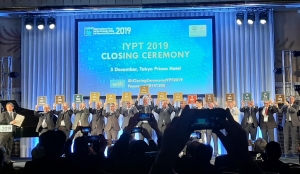End of the year of Periodic Table – with our accent
06-12-2019
On December 5th in Tokio, a closing ceremony for the International Year of the Periodic Table of Elements has been held. The year’s theme was established by UNESCO on the 150th anniversary of the publication of the first version of the table of elements by Dmitry Mendeleev. The celebration was preceded by a four-day international conference Super Heavy Elements (SHE2019), with participation of several world’s leading scientists specialising in the field of superheavy elements. Among them, there were three scientists form Polish institutes. NCBJ was represented by Professor Michał Kowal, co-creator of promising theoretical predictions regarding the possibility of producing new superheavy nuclides in laboratory conditions.
Recent years have brought tremendous acceleration in international research into the heaviest elements. They are usually produced by bombarding specially prepared shields – sometimes radioactive – with projectiles, which are selected lighter atomic nuclei accelerated in accelerators. The new elements produced this way are extremely short-lived. Confirmation of their creation requires the construction of very precise separating and measuring devices. Only a few centres in the world have such possibilities. As always, scientists from Dubna in Russia and from Darmstadt in Germany excel in this field. This was also reflected in the choice of the names of elements associated with the headquarters of the laboratories (Dubnium – Db, 105; Moscovium – Mc, 115; Darmstadtium – Ds., 110; Hassium – Hs, 108) and with the names of the scientists (Flerovium – FL, 114; Oganesson – Og, 118). The Japanese, who are proud of their laboratory in Riken, have also made great progress. Their merit was honoured with the name of the element Nihonium – Nh, 113. These great successes in the production of new elements were possible thanks to manufacturing of radioactive materials, which are then used to build targets for nuclear reactions. The American team from Oak Ridge National Lab (the element Tennessine – Ts, 117 was named in their honour) and Lawrence Livermore National Laboratory (Livermorium – Lv, 116) invaluably aided in this difficult task.
Poland does not have sufficiently powerful laboratories, but the work of our scientists, focusing largely on theoretical analyses and predictions, is widely noticed and appreciated, hence the presence of our physicists in such an elite group at ceremonies in Japan. The late Professor Adam Sobiczewski form NCBJ made huge contributions to the development of this field of research in Poland. Polish colleagues are actively supported by Professor Krzysztof Rykaczewski – a world –class expert who has been working in the USA for years. In our Institute, in recent years, a team of scientists form the NCBJ Theoretical Physics Department, in which the NCBJ professors Janusz Skalski and Michał Kowal play a leading role, has been very successful. Their team’s works, containing predictions as to the possibility of producing even heavier elements, aroused great interest in the international environment. At the conference, Professor Kowal presented the initial results of their next research. They relate to the search of super stable nuclear states, this time based on the excitation of three nucleons. For the first time, the mechanisms of forbiddance essential for the stability of such states were presented at the conference just concluded in Japan, which took place in the picturesque area „in the shadow” of Mount Fuji.
150 years after the first presentation of the Mendeleev table, there is still a peculiar race of laboratories and the most powerful minds, to fill it up with new elements: scientists are looking for elements with atomic numbers 119 and 120, the synthesis of which will probably be confirmed soon.
150 lat po pierwszym zaprezentowaniu tablicy Mendelejewa nadal toczy się swoisty wyścig laboratoriów i najtęższych umysłów, by dodać do niej nowe elementy: naukowcy poszukują pierwiastków o liczbach atomowych 119 i 120, których synteza prawdopodobnie zostanie potwierdzona już wkrótce.





